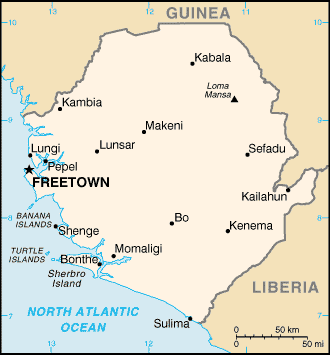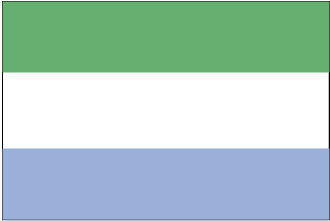
|
Sierra Leone
Background:
Since 1991, civil war between the government and the Revolutionary United Front
(RUF) has resulted in tens of thousands of deaths and the displacement of more
than 2 million people (well over one-third of the population), many of whom are
now refugees in neighboring countries. After several setbacks, the end to the
11-year conflict in Sierra Leone may finally be near at hand. National
elections were
held in May 2002 and the government continues to slowly reestablish its
authority.
Location:
Location: Western Africa, bordering the North Atlantic Ocean, between Guinea
and Liberia.
Area: Total: 71,740 sq km, land: 71,620 sq km, water: 120 sq km.
Area - comparative: Slightly smaller than South Carolina.
Land boundaries: Total: 958 km, border countries: Guinea 652 km, Liberia 306
km.
Coastline: 402 km.
Climate and Terrain:
Climate: Tropical; hot, humid; summer rainy season (May to December); winter
dry season (December to April).
Terrain: Coastal belt of mangrove swamps, wooded hill country, upland plateau,
mountains in east.
Natural resources: Diamonds, titanium ore, bauxite, iron ore, gold, chromite.
People:
Population: 5,732,681.
Ethnic groups: 20 native African tribes 90% (Temne 30%, Mende 30%, other 30%),
Creole (Krio) 10% (descendants of freed Jamaican slaves who were settled in the
Freetown area in the late-18th century), refugees from Liberia's recent civil
war, small numbers of Europeans, Lebanese, Pakistanis, and Indians.
Religions: Muslim 60%, indigenous beliefs 30%, Christian 10%.
Languages: English (official, regular use limited to literate minority), Mende
(principal vernacular in the south), Temne (principal vernacular in the north),
Krio (English-based Creole, spoken by the descendants of freed Jamaican slaves
who were settled in the Freetown area, a lingua franca and a first language for
10% of the population but understood by 95%).
Government:
Government type: Constitutional democracy.
Capital: Freetown.
Independence: 27 April 1961 (from UK).
Economy overview:
Sierra Leone is an extremely poor African nation with tremendous inequality
in income distribution. It does have substantial mineral, agricultural, and
fishery resources. However, the economic and social infrastructure is not well
developed, and serious social disorders continue to hamper economic
development, following a 11-year civil war. About two-thirds of the working-age
population engages in subsistence agriculture. Manufacturing consists mainly of
the processing of raw materials and of light manufacturing for the domestic
market. Plans continue to reopen bauxite and rutile mines shut down during the
conflict. The major source of hard currency consists of the mining of diamonds.
Statistics:
Telephones - main lines in use: 25,000.
Telephones - mobile cellular: 30,000.
Radio broadcast stations: AM 1, FM 9, shortwave 1.
Radios: 1.12 million.
Television broadcast stations: 2.
Televisions: 53,000.
Internet users: 20,000.
Railways: total: 84 km.
Highways: Total: 11,330 km, paved: 895 km,. unpaved: 10,435 km.
Airports - with paved runways: 1, with unpaved runways: 9.
Heliports: 2.
Return to Visiting Locations
|

